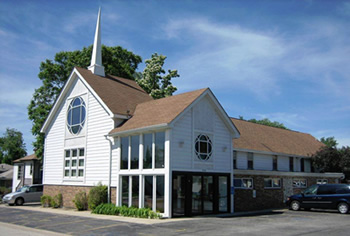“And with that he breathed on them and said,
‘Receive the Holy Spirit.’ ”
John 20:22
When Jesus gave the Holy Spirit to his disciples on the day he rose from the dead, he was not “baptizing” them in the Spirit as they would experience later during Pentecost (Acts 1:5; 2:4). Rather, it was the first time the disciples actually received the spiritually renewing presence of the Holy Spirit–the same Spirit that raised Jesus from the dead Romans 8:11, “And if the Spirit of him who raised Jesus from the dead is living in you, he who raised Christ from the dead will also give life to your mortal bodies through his Spirit, who lives in you.” The Spirit would now live within them. The inner presence of the Holy Spirit is part of the new life that all Christ’s followers now receive at the time they accept Christ’s forgiveness and surrender their lives to him.
(1) During Jesus’ last message to his disciples–right before his arrest, trial and crucifixion–he promised them that they would receive the Holy Spirit as the One who would regenerate them (i.e., renew them spiritually): “he lives with you and will be in you”, John 14:17. Jesus fulfilled thatpromise when he was with them following his resurrection.
(2) It is reasonable to conclude that John 20:22 refers to regeneration (i.e., spiritual birth and renewal by the Holy Spirit) because of the phrase, “he breathed on them.” The Greek word for “breathed” (emphusaö) is the same verb used in the Septuagint (the Greek translation of the OT) in Genesis 2:7, where God “breathed into his [Adam’s] nostrils the breath of life, and the man became a living being.” It is the same verb found in Ezekiel 37:9, “Breathe into these slain, that they may live.” John’s use of this verb (related also to the life-giving process as in the other references) suggests that Jesus was giving the Holy Spirit in order to bring life and “a new creation”, 2 Corinthians 5:17. Just as God breathed “the breath of life” into the first man’s physical body “and the man became a living being”, Genesis 2:7–a new creation–so Jesus breathed on the disciples and they each became a new creation in a spiritual sense. Through his resurrection, Jesus became a “life-giving spirit” 1 Corinthians 15:45.
(3) The phrase, “Receive the Holy Spirit,” indicates, or shows, that the Spirit, at that historical moment, entered the disciples and began to live in and through them. The verb form for “receive” is aorist imperative (Gk labete, from the word lambanö), implying a single, immediate act of receiving–something that definitely happened at that point in time. The Holy Spirit was given to renew the disciples spiritually, giving them new birth into a personal relationship with Christ (cf. 2Corinthians 5:17, 18). This “receiving” of new life from the Spirit was a prerequisite to their receiving the authority of Jesus (John 20:23) and their baptism in the Holy Spirit on the day of Pentecost (Acts2:4).
(4) Prior to this time, the disciples were technically true believers and followers of Jesus and were saved according to the provisions of the old covenant (i.e., God’s laws and promises that allowed his people to maintain a relationship with him before Christ came, died and rose again). Yet they were not regenerated (i.e., spiritually re-created and renewed) in the full new covenant sense. It was not until this point that the disciples entered into the new covenant–the “life agreement” based on Jesus’ life, death and resurrection. It was also technically at this point in time, and not at Pentecost, that the church–the community of all true followers of Jesus with the purpose to honor him and spread his message to all the world–was born. The spiritual birth of the first disciples and the birth of the church are one and the same.
(5) This passage is crucial in understanding the Holy Spirit’s ministry to God’s people. These two statements are true: (a) The disciples received the Holy Spirit (to live within them and renew them spiritually) before the day of Pentecost. (b) The outpouring of the Spirit in Acts 2:4–when God generously sent his Spirit to fill, commission and empower his first followers–was an experience that occurred after the disciples had already been spiritually renewed (reborn) by the Spirit. For this reason, their baptism in the Spirit at Pentecost is considered a second and separate work of the Spirit in them.
(6) These two separate and distinct works of the Holy Spirit in the lives of Jesus’ disciples can and should be the norm for all Christians to this day. The baptism in the Holy Spirit is available to give supernatural power to all who have already received spiritual salvation. All believers receive the Holy Spirit at the time of their spiritual birth (i.e., initial salvation, Romans 8:9, You, however, are controlled not by the sinful nature but by the Spirit, if the Spirit of God lives in you. And if anyone does not have the Spirit of Christ, he does not belong to Christ.)–when they first accept God’s gift of forgiveness and eternal life through faith in Christ. After this, they can and should experience the baptism in the Holy Spirit for supernatural power to be Jesus’ witnesses and to spread his message, Acts 1:8, But you will receive power when the Holy Spirit comes on you; and you will be my witnesses in Jerusalem, and in all Judea and Samaria, and to the ends of the earth.”.
(7) There is no Biblical basis for believing or understanding that Jesus’ words “Receive the Holy Spirit,” as recorded in John 20:22 were only symbolic and prophetic of the Holy Spirit’s coming at Pentecost as described in Acts 2. The use of the aorist imperative form of “receive” (see above) suggests that the disciples received the Holy Spirit at that moment and in that place, just as John records the event.
Fire Bible Study Notes


